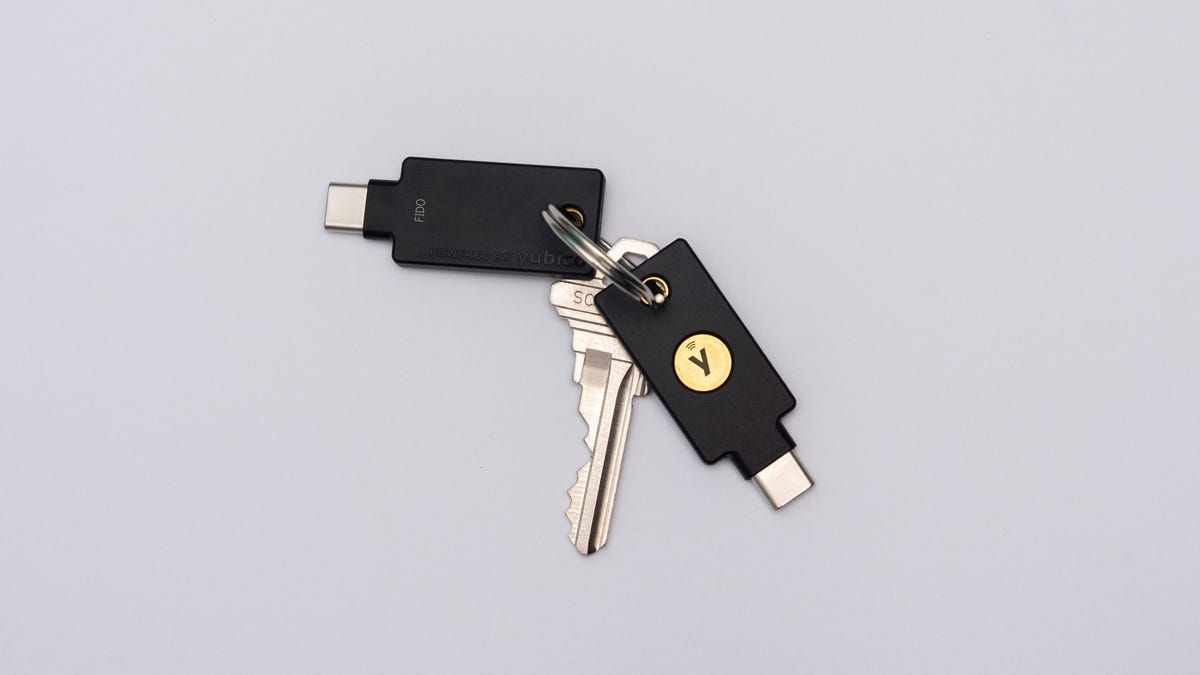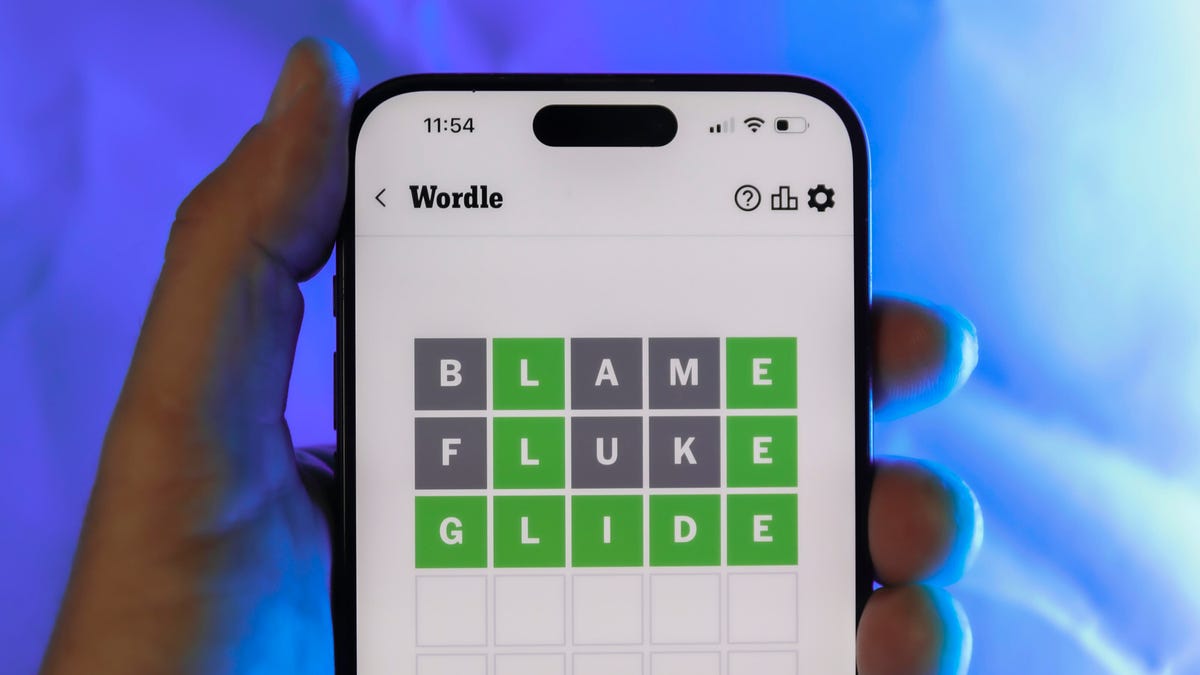Technologies
New iOS Login Tech Makes It Super Hard to Hack Your iCloud Account
Hardware security keys are the most secure way to lock down your online accounts. Just don’t lose the keys.

Apple now lets you protect your Apple ID and iCloud account with hardware security keys, a significant upgrade for those who want maximum protection from hackers, identity thieves, or snoops.
Hardware security keys are small physical devices that communicate with USB or Lightning ports or with NFC wireless data connections when you’re logging on to a device or in to an account. Because you must have keys in your possession to use them, they’re effective at thwarting hackers trying to reach your account remotely. And they won’t work on fake login sites, so they can thwart phishing attacks that try to fool you into typing your password onto a counterfeit website.
Support for the keys arrived Monday with iOS 16.3 and MacOS 13.2, and on Tuesday, Apple published details on how to use security keys with iPhones, iPads and Macs. The company requires you to set up at least two keys.
Apple has been working to tighten security in recent months, stung by iPhone breaches involving NSO Group’s Pegasus spyware. Apple’s Advanced Data Protection option arrived in December, giving a stronger encryption option to data stored and synced with iCloud. And in September, Apple added an iPhone Lockdown Mode that includes new guardrails on how your phone works to thwart outside attacks.
A big caveat, though: Although hardware security keys and the Advanced Data Protection program lock down your account better, they also mean Apple can’t help you recover access.
«This feature is designed for users who, often due to their public profile, face concerted threats to their online accounts, such as celebrities, journalists, and members of government,» Apple said in a statement. «This takes our two-factor authentication even further, preventing even an advanced attacker from obtaining a user’s second factor in a phishing scam.»
Industry tightens login security
The technology is part of an industrywide tightening of authentication procedures. Thousands of data breaches have shown the weaknesses of traditional passwords, and hackers now can thwart common two-factor authentication technologies like security codes sent by text message. Hardware security keys and another approach called passkeys offer peace of mind even when it comes to serious attacks like hackers gaining access to LastPass customers’ password manager files.
Hardware security keys have been around for years, but the Fast Identity Online, or FIDO, group has helped standardize the technology and integrate its use with websites and apps. One big advantage on the web is they’re linked to specific websites, for example Facebook or Twitter, so they thwart phishing attacks that try to get you to log in to fake websites. They’re the foundation for Google’s Advanced Protection Program, too, for those who want maximum security.
You need to pick the right hardware security keys for your devices. To communicate with relatively new models of both Macs and iPhones, a key that supports USB-C and NFC is a good option. Apple requires you to have two keys, but it isn’t a bad idea to have more in case you lose them. A single key can be used to authenticate to many different devices and services, like your Apple, Google and Microsoft accounts.
Yubico, the top maker of hardware security keys, announced on Tuesday two new FIDO-certified YubiKey models in its Security Key Series suited for consumers. They both support NFC, but the $29 model has a USB-C connector and the $25 model has an older style USB-A connector.
Google, Microsoft, Apple and other allies are also working to support a different FIDO authentication technology called passkeys. Passkeys are designed to replace passwords altogether, and they don’t require hardware security keys.
Technologies
Today’s NYT Connections: Sports Edition Hints and Answers for Nov. 24, #427
Here are hints and the answers for the NYT Connections: Sports Edition puzzle for Nov. 24, No. 427.

Looking for the most recent regular Connections answers? Click here for today’s Connections hints, as well as our daily answers and hints for The New York Times Mini Crossword, Wordle and Strands puzzles.
Music lovers, today’s Connections: Sports Edition has a fun green category for you. You’ll recognize some familiar phrases in the grid, I think. If you’re struggling with today’s puzzle but still want to solve it, read on for hints and the answers.
Connections: Sports Edition is published by The Athletic, the subscription-based sports journalism site owned by The Times. It doesn’t appear in the NYT Games app, but it does in The Athletic’s own app. Or you can play it for free online.
Read more: NYT Connections: Sports Edition Puzzle Comes Out of Beta
Hints for today’s Connections: Sports Edition groups
Here are four hints for the groupings in today’s Connections: Sports Edition puzzle, ranked from the easiest yellow group to the tough (and sometimes bizarre) purple group.
Yellow group hint: Not long pants.
Green group hint: Sing out.
Blue group hint: Gridiron guys who share a name.
Purple group hint: Like a law.
Answers for today’s Connections: Sports Edition groups
Yellow group: Types of shorts.
Green group: Popular arena/stadium songs.
Blue group: Football Drews.
Purple group: ____ rule.
Read more: Wordle Cheat Sheet: Here Are the Most Popular Letters Used in English Words
What are today’s Connections: Sports Edition answers?
The yellow words in today’s Connections
The theme is types of shorts. The four answers are basketball, bike, compression and gym.
The green words in today’s Connections
The theme is popular arena/stadium songs. The four answers are Eye of the Tiger, Jump Around, Sandstorm and Thunderstruck.
The blue words in today’s Connections
The theme is football Drews. The four answers are Bledsoe, Brees, Lock and Pearson.
The purple words in today’s Connections
The theme is ____ rule. The four answers are infield fly, mercy, tuck and unwritten.
Don’t miss any of our unbiased tech content and lab-based reviews. Add CNET as a preferred Google source.
Technologies
Today’s NYT Mini Crossword Answers for Monday, Nov. 24
Here are the answers for The New York Times Mini Crossword for Nov. 24.

Looking for the most recent Mini Crossword answer? Click here for today’s Mini Crossword hints, as well as our daily answers and hints for The New York Times Wordle, Strands, Connections and Connections: Sports Edition puzzles.
Need some help with today’s Mini Crossword? Two down might be my favorite clue, and answer, this puzzle has ever offered. Read on for all of the answers. And if you could use some hints and guidance for daily solving, check out our Mini Crossword tips.
If you’re looking for today’s Wordle, Connections, Connections: Sports Edition and Strands answers, you can visit CNET’s NYT puzzle hints page.
Read more: Tips and Tricks for Solving The New York Times Mini Crossword
Let’s get to those Mini Crossword clues and answers.
Mini across clues and answers
1A clue: Prefix for some music genres
Answer: ALT
4A clue: Fab ___ (nickname for the Beatles)
Answer: FOUR
6A clue: Eagle’s claw
Answer: TALON
8A clue: Fab ___ (nickname for a noted University of Michigan basketball team)
Answer: FIVE
9A clue: Congregant’s seat
Answer: PEW
Mini down clues and answers
1D clue: Boat’s rear
Answer: AFT
2D clue: Shape of a cat with its legs tucked under itself
Answer: LOAF
3D clue: Flower that’s the subject of Dutch festivals
Answer: TULIP
5D clue: Wander aimlessly
Answer: ROVE
7D clue: Like many shows at the top of the Netflix queue
Answer: NEW
Don’t miss any of our unbiased tech content and lab-based reviews. Add CNET as a preferred Google source.
Technologies
Today’s Wordle Hints, Answer and Help for Nov. 24, #1619
Today’s Wordle is tricky. Here are hints, answers and help for Nov. 24, #1619.

Looking for the most recent Wordle answer? Click here for today’s Wordle hints, as well as our daily answers and hints for The New York Times Mini Crossword, Connections, Connections: Sports Edition and Strands puzzles.
Today’s Wordle puzzle is a little tricky. If you need a new starter word, check out our list of which letters show up the most in English words. If you need hints and the answer, read on.
Today’s Wordle hints
Before we show you today’s Wordle answer, we’ll give you some hints. If you don’t want a spoiler, look away now.
Wordle hint No. 1: Repeats
Today’s Wordle answer has no repeated letters.
Wordle hint No. 2: Vowels
Today’s Wordle answer has two vowels.
Wordle hint No. 3: First letter
Today’s Wordle answer begins with D.
Wordle hint No. 4: Last letter
Today’s Wordle answer ends with H.
Wordle hint No. 5: Meaning
Today’s Wordle answer is a flour-based mixture used to bake bread.
TODAY’S WORDLE ANSWER
Today’s Wordle answer is DOUGH.
Yesterday’s Wordle answer
Yesterday’s Wordle answer, Nov. 23, No. 1618 was BUNNY.
Recent Wordle answers
Nov. 19, No. 1614: MAKER
Nov. 20, No. 1615: GRAVE
Nov. 21, No. 1616: VOWEL
Nov. 22, No. 1617: THICK
-

 Technologies3 года ago
Technologies3 года agoTech Companies Need to Be Held Accountable for Security, Experts Say
-

 Technologies3 года ago
Technologies3 года agoBest Handheld Game Console in 2023
-

 Technologies3 года ago
Technologies3 года agoTighten Up Your VR Game With the Best Head Straps for Quest 2
-

 Technologies4 года ago
Technologies4 года agoBlack Friday 2021: The best deals on TVs, headphones, kitchenware, and more
-

 Technologies4 года ago
Technologies4 года agoVerum, Wickr and Threema: next generation secured messengers
-

 Technologies4 года ago
Technologies4 года agoGoogle to require vaccinations as Silicon Valley rethinks return-to-office policies
-

 Technologies4 года ago
Technologies4 года agoOlivia Harlan Dekker for Verum Messenger
-

 Technologies4 года ago
Technologies4 года agoiPhone 13 event: How to watch Apple’s big announcement tomorrow
